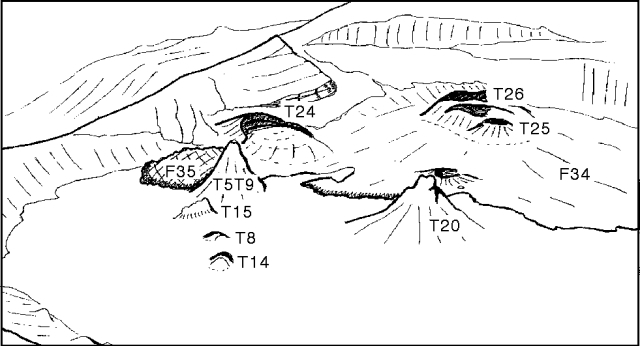Report on Ol Doinyo Lengai (Tanzania) — August 1993
Bulletin of the Global Volcanism Network, vol. 18, no. 8 (August 1993)
Managing Editor: Edward Venzke.
Ol Doinyo Lengai (Tanzania) Description of crater in early July
Please cite this report as:
Global Volcanism Program, 1993. Report on Ol Doinyo Lengai (Tanzania) (Venzke, E., ed.). Bulletin of the Global Volcanism Network, 18:8. Smithsonian Institution. https://doi.org/10.5479/si.GVP.BGVN199308-222120
Ol Doinyo Lengai
Tanzania
2.764°S, 35.914°E; summit elev. 2962 m
All times are local (unless otherwise noted)
Aerial photographs taken on 3 July (figure 30) revealed morphological changes that resulted from the vigorous activity in June, perhaps the greatest level of activity since the current eruption began in 1983. Explosive eruptions deposited ash on the outer slopes of the cone, lava fountaining ejected volcanic bombs across the crater floor, new vents opened in the S part of the crater floor, and carbonatitic lava flowed down the outer, W slopes of the cone. No liquid lava could be seen on 3 July in any of the vents or flowing on the crater floor, though much of the S and E parts of the crater were very black. Moderate steam emissions were coming from the W and N crater rims, from T20, and from T5/T9. Fresh white ash covered much of the summit, the extinct S crater, and the SE slopes.
 |
Figure 30. Panorama of Ol Doinyo Lengai crater looking S, 3 July 1993. Crater diameter is ~200 m. Drawn by C. Nyamweru from aerial photographs. |
During fieldwork on 29 June, most of the crater floor was covered by dark, very fresh lava with both blocky and ropy textures. Lava flows were especially thick to the S, where the crater floor was higher than T14 in the N. A large slab of the crater wall near T24 had split from the rim and was standing free. The new vent near the center of the crater (T23) consisted of a smooth outer white cone surrounding smaller, black cones from which liquid lava fragments were being thrown. A recent lava flow from T23 extended N between T8 and T14, which were still visible but surrounded by lava flows from other vents. Vent T20 was taller than T5/T9, previously the tallest feature. Vent T24, wider than T20 but not as high, was the source of a large, 7-8 m thick flow of blocky lava (F35). This flow was not moving on 29 June, but fragments were falling down the flow front and its color was still dark. A circular fresh-looking black cone (T25) in the S was the source of a large flow of blocky lava (F34) that covered much of the S crater floor. Feature T26, a large black half-cone close to the base of the S crater wall, might have been the source of volcanic bombs (
Geological Summary. The symmetrical Ol Doinyo Lengai is the only volcano known to have erupted carbonatite tephras and lavas in historical time. The prominent stratovolcano, known to the Maasai as "The Mountain of God," rises abruptly above the broad plain south of Lake Natron in the Gregory Rift Valley. The cone-building stage ended about 15,000 years ago and was followed by periodic ejection of natrocarbonatitic and nephelinite tephra during the Holocene. Historical eruptions have consisted of smaller tephra ejections and emission of numerous natrocarbonatitic lava flows on the floor of the summit crater and occasionally down the upper flanks. The depth and morphology of the northern crater have changed dramatically during the course of historical eruptions, ranging from steep crater walls about 200 m deep in the mid-20th century to shallow platforms mostly filling the crater. Long-term lava effusion in the summit crater beginning in 1983 had by the turn of the century mostly filled the northern crater; by late 1998 lava had begun overflowing the crater rim.
Information Contacts: C. Nyamweru, St. Lawrence Univ.

